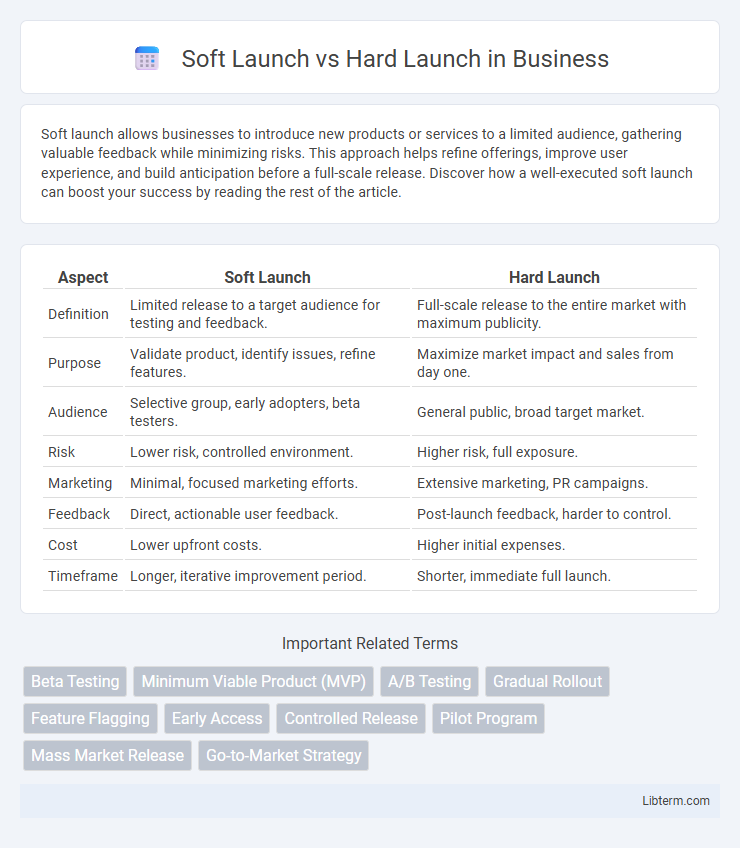Soft launch allows businesses to introduce new products or services to a limited audience, gathering valuable feedback while minimizing risks. This approach helps refine offerings, improve user experience, and build anticipation before a full-scale release. Discover how a well-executed soft launch can boost your success by reading the rest of the article.
Table of Comparison
| Aspect | Soft Launch | Hard Launch |
|---|---|---|
| Definition | Limited release to a target audience for testing and feedback. | Full-scale release to the entire market with maximum publicity. |
| Purpose | Validate product, identify issues, refine features. | Maximize market impact and sales from day one. |
| Audience | Selective group, early adopters, beta testers. | General public, broad target market. |
| Risk | Lower risk, controlled environment. | Higher risk, full exposure. |
| Marketing | Minimal, focused marketing efforts. | Extensive marketing, PR campaigns. |
| Feedback | Direct, actionable user feedback. | Post-launch feedback, harder to control. |
| Cost | Lower upfront costs. | Higher initial expenses. |
| Timeframe | Longer, iterative improvement period. | Shorter, immediate full launch. |
Understanding Soft Launch vs Hard Launch
Soft launch involves releasing a product to a limited audience to gather feedback and identify issues before a full-scale release, optimizing product-market fit and minimizing risks. Hard launch is the official, wide-scale release targeting the entire market, focusing on maximum visibility and rapid user acquisition. Understanding the differences helps businesses strategically plan product rollouts, balancing testing with marketing impact.
Key Differences Between Soft and Hard Launches
A soft launch involves releasing a product or service to a limited audience to gather feedback and identify issues, while a hard launch targets the entire market with full promotional efforts. Soft launches prioritize testing and refinement, minimizing risk and allowing for adjustments before wider exposure, whereas hard launches focus on maximizing initial impact and market penetration. The choice between soft and hard launches depends on strategic goals, resource availability, and the desired level of market readiness.
Benefits of a Soft Launch
A soft launch allows businesses to test new products or services with a limited audience, gathering valuable feedback to refine features and fix issues before a full-scale release. This approach minimizes risk by identifying potential problems early, optimizing user experience, and improving market fit. Companies can also build initial buzz and adjust marketing strategies based on real-world performance data, leading to higher overall success during the subsequent hard launch.
Advantages of a Hard Launch
A hard launch offers immediate full-scale market entry, enabling faster brand visibility and customer acquisition compared to a soft launch. This approach generates significant initial revenue and provides comprehensive real-time feedback on product performance under full demand conditions. Hard launches also create stronger market impact and competitive positioning by showcasing confidence and commitment to the product.
Ideal Scenarios for Soft Launch
A soft launch is ideal for mobile apps or games targeting specific regions or user demographics to gather user feedback and identify bugs before a full-scale release. This approach works best when testing server capacity, marketing strategies, and user engagement in a controlled environment without risking brand reputation. Startups and companies with limited budgets benefit from soft launches to optimize product performance and reduce launch-day risks.
When to Choose a Hard Launch
A hard launch is ideal when a product or service is fully developed, rigorously tested, and ready for immediate market entry with a comprehensive marketing campaign. Companies opt for a hard launch to maximize initial impact, achieve rapid customer acquisition, and establish brand presence quickly. This approach is often chosen when the target audience is well-defined and the product has a clear competitive advantage that can generate strong demand from day one.
Common Mistakes in Launch Strategies
Common mistakes in soft launch strategies include insufficient user feedback analysis and prematurely scaling up before product-market fit is confirmed. Hard launch errors often stem from inadequate market testing and unrealistic expectations for immediate mass adoption, leading to rapid negative reviews or high churn rates. Both approaches fail when ignoring targeted audience segmentation and neglecting continuous iteration based on performance data.
Success Stories: Soft Launch vs Hard Launch
Soft launch strategies have driven success for companies like Supercell, whose gradual rollout of Clash of Clans allowed extensive user feedback and iterative improvements before a global release. In contrast, Apple's hard launch approach for the iPhone garnered massive immediate impact and market dominance through high-profile events and extensive media coverage. These examples highlight how soft launches enable refinement and optimization, while hard launches leverage hype and instant scalability for maximal initial success.
Metrics to Measure Launch Success
Soft launches prioritize metrics such as user acquisition rate, retention rate, and in-app engagement to gauge early performance and identify areas for improvement before a full release. Hard launches focus on broader impact metrics including total downloads, revenue generation, market penetration, and brand awareness to measure overall success and return on investment. Tracking customer feedback and technical stability across both launch types is essential to optimize product performance and user satisfaction.
Choosing the Right Launch Strategy
Choosing the right launch strategy between a soft launch and a hard launch depends on product readiness, target audience feedback, and risk tolerance. A soft launch allows for controlled market testing, gathering user insights, and iterative improvements before a full-scale release. In contrast, a hard launch demands thorough preparation and aims for maximum impact, ideal for products with confident performance and established demand.
Soft Launch Infographic

 libterm.com
libterm.com